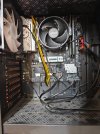you’re running an
MSI B650M Gaming WiFi (mATX) with a
Ryzen 5 8500G, 48 GB DDR5, and
two NVMe Gen4 SSDs, and you want to add a GPU but are worried about
bandwidth/performance drops due to PCIe lane allocation.
Let’s break this down carefully.
 How PCIe lanes work on your setup
How PCIe lanes work on your setup
- Ryzen 5 8500G (AM5, Zen 4, integrated graphics) has:
- 16 PCIe 4.0 lanes from the CPU for graphics cards.
- 4 PCIe 4.0 lanes from the CPU for your primary NVMe slot (usually M.2_1).
- The B650M chipset adds more PCIe lanes (Gen4 and Gen3) for additional devices like M.2_2, SATA, USB, etc.
- Your two NVMe SSDs will not “steal” bandwidth from the GPU — unless your motherboard manual says a specific slot shares lanes with the PCIe x16 slot (which it usually doesn’t on B650 boards, but worth double-checking in the manual for MS-7E30).
 Bandwidth concerns
Bandwidth concerns
- Your main GPU slot is PCIe 4.0 x16 direct from the CPU — perfect for modern GPUs.
- Even if a GPU ran at PCIe 4.0 x8, the performance loss on current cards is minimal (1–3% in most cases).
- NVMe drives usually only share lanes with chipset-controlled slots, not the main GPU slot.
So:
No real bottleneck worries for GPU performance in your case.
 GPU recommendation for your build
GPU recommendation for your build
Since your Ryzen 5 8500G already has iGPU, adding a dedicated GPU will greatly improve gaming/rendering.
The
best choice depends on your
budget and monitor resolution:
- 1080p High/Ultra Gaming
- NVIDIA RTX 3060 Ti / RTX 4060 Ti
- AMD RX 6600 XT / RX 7600 XT
- 1440p High/Ultra
- NVIDIA RTX 4070 / RTX 4070 Super
- AMD RX 6700 XT / RX 7700 XT
- 4K or heavy productivity (video editing, 3D)
- NVIDIA RTX 4070 Ti Super / 4080 Super
- AMD RX 7900 XT / XTX
 Practical advice
Practical advice
- Check your power supply wattage and connectors before picking a GPU.
- Make sure your mATX case has clearance for the card’s length.
- If you want best compatibility and efficiency, RTX 4070 is a great balance — runs cool, needs only PCIe 4.0 x8/x16, and won’t be bottlenecked.
- If you want best value, RX 6700 XT or RX 7700 XT is a strong pick.

